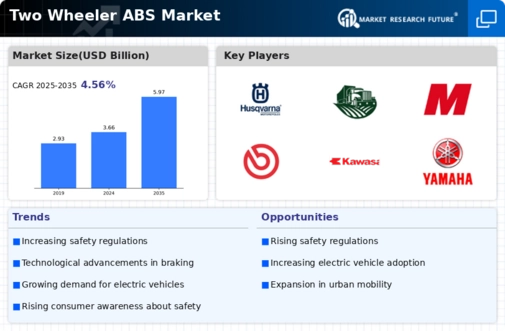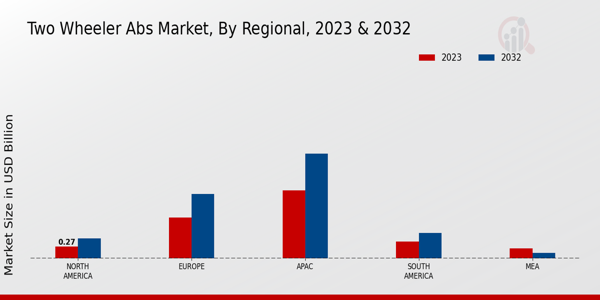Market Growth Projections
The Global Two Wheeler ABS Market Industry is poised for substantial growth, with projections indicating a market value of 3.66 USD Billion in 2024 and an anticipated increase to 5.97 USD Billion by 2035. This growth trajectory suggests a compound annual growth rate of 4.55% from 2025 to 2035, reflecting the increasing adoption of ABS technology across various regions. The market dynamics are influenced by factors such as regulatory changes, consumer preferences for safety features, and advancements in technology. These projections underscore the industry's potential for expansion and the ongoing evolution of two-wheeler safety systems.
Increasing Safety Regulations
The Global Two Wheeler ABS Market Industry is experiencing a notable shift due to the implementation of stringent safety regulations across various regions. Governments are increasingly mandating the installation of Anti-lock Braking Systems (ABS) in two-wheelers to enhance rider safety. For instance, the European Union has set regulations that require ABS in all new motorcycles, which has significantly influenced manufacturers to adopt this technology. This regulatory push is expected to drive the market's growth, contributing to a projected market value of 3.66 USD Billion in 2024, with further expansion anticipated as safety standards evolve.
Technological Advancements in ABS Systems
Technological innovations are playing a pivotal role in shaping the Global Two Wheeler ABS Market Industry. Manufacturers are investing in research and development to enhance the efficiency and effectiveness of ABS systems. Recent advancements include the integration of sensors and electronic control units that optimize braking performance under various conditions. Such innovations not only improve rider safety but also enhance the overall riding experience. As these technologies become more accessible, the market is likely to witness a compound annual growth rate of 4.55% from 2025 to 2035, reflecting the industry's commitment to continuous improvement and adaptation.
Growth of the Electric Two Wheeler Segment
The rise of electric two-wheelers is significantly influencing the Global Two Wheeler ABS Market Industry. As electric vehicles gain traction due to environmental concerns and government incentives, the demand for ABS in this segment is also increasing. Electric two-wheelers often require advanced braking systems to manage their unique performance characteristics, making ABS a critical component. This trend is expected to bolster market growth, as manufacturers are likely to prioritize safety features in their electric models. The integration of ABS in electric two-wheelers could further enhance the market's value, aligning with the broader shift towards sustainable transportation solutions.
Rising Demand for Enhanced Safety Features
Consumer preferences are shifting towards vehicles equipped with advanced safety features, thereby propelling the Global Two Wheeler ABS Market Industry. As riders become more aware of the benefits of ABS, including improved braking performance and reduced stopping distances, manufacturers are responding by integrating these systems into their models. This trend is particularly evident in urban areas where traffic congestion and accident rates are high. The increasing demand for safer two-wheelers is projected to contribute to a market valuation of 5.97 USD Billion by 2035, indicating a robust growth trajectory driven by consumer awareness and safety concerns.
Increasing Urbanization and Traffic Congestion
Urbanization is a key driver of the Global Two Wheeler ABS Market Industry, as more individuals turn to two-wheelers for their commuting needs. The rapid growth of urban populations has led to increased traffic congestion, making safety a paramount concern for riders. As a result, the demand for two-wheelers equipped with ABS is on the rise, as these systems provide enhanced control and stability in challenging traffic conditions. This trend is likely to contribute to the overall market growth, as urban commuters seek safer and more reliable transportation options in densely populated areas.




















